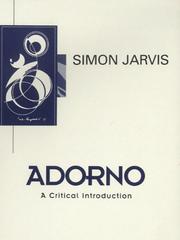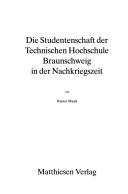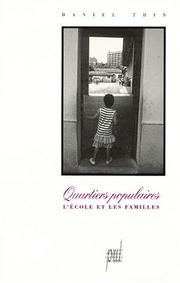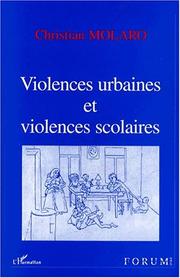| Listing 1 - 10 of 11 | << page >> |
Sort by
|
Book
ISBN: 9036511380 9789036511384 Year: 1998 Publisher: Enschede : Twente university press,
Abstract | Keywords | Export | Availability | Bookmark
 Loading...
Loading...Choose an application
- Reference Manager
- EndNote
- RefWorks (Direct export to RefWorks)
Kongre�. --- Schule. --- Flandern --- Niederlande.

ISBN: 0745611796 Year: 1998 Publisher: Cambridge Polity
Abstract | Keywords | Export | Availability | Bookmark
 Loading...
Loading...Choose an application
- Reference Manager
- EndNote
- RefWorks (Direct export to RefWorks)

ISBN: 3786814538 9783786814535 Year: 1998 Volume: 453 Publisher: Husum Matthiesen
Abstract | Keywords | Export | Availability | Bookmark
 Loading...
Loading...Choose an application
- Reference Manager
- EndNote
- RefWorks (Direct export to RefWorks)
College students --- History --- Technische Hochschule Carolo-Wilhelmina zu Braunschweig --- -College life --- Universities and colleges --- University students --- Students --- -Education --- -Braunschweig (Germany). --- Brunswick (City). --- Technische Hochschule Braunschweig --- TH Braunschweig --- Herzogliche Polytechnische Schule (Braunschweig, Germany) --- Technische Universität Braunschweig --- -History --- -Technische Hochschule Carolo-Wilhelmina zu Braunschweig --- College life --- Education --- Braunschweig (Germany). --- History. --- College students - Germany - Braunschweig - History - 20th century
Book
ISBN: 0300076495 0300064381 9780300064384 Year: 1998 Publisher: New Haven, Conn. Yale University Press
Abstract | Keywords | Export | Availability | Bookmark
 Loading...
Loading...Choose an application
- Reference Manager
- EndNote
- RefWorks (Direct export to RefWorks)
Must avant-garde art hold itself apart from the values and beliefs widely held in the common culture? Must advanced artists always be the symbolic adversaries of the ordinary citizen? These questions have dominated, even paralyzed the modern art world, particularly in recent years when perceived elitism and imposed canons of taste have come under fire from all sides. In this stimulating book, a prominent art historian shows that the links between advanced art and modern mass culture have always been robust, indeed necessary to both. Thomas Crow focuses on the continual interdependence between the two phenomena, providing examples that range from Paris in the mid-nineteenth century to the latest revivals of Conceptual art in the 1990s. Crow's argument proceeds through a series of vividly described episodes: Jackson Pollock being enlisted into the realm of fashion by his first patron; Andy Warhol keeping one foot in a small-town sentiment through his definitive work of the 1960s; an audacious woman artist, Sturtevant, confronting incomprehension and hostility when she turned Pop art tactics against the Pop painters themselves (and being vindicated twenty years later by an entirely new generation of artists); Gerhard Richter's sophisticated painting converging with amateur production in its uses of photography; Gordon Matta-Clark raiding derelict buildings to find the raw material of his sculpture; Ross Bleckner redefining his painting of the 1980s through the decayed, funerary kitsch of Victorian America; Christopher Williams remaking a high Conceptual art with mental maps provided by the tourist industry. From inquiry into these and many other cases comes a new and fresh kind of cultural theory, one no longer imposed on artists from the outside but instead made from within the living practice of art.
Art --- anno 1900-1999 --- anno 1800-1899 --- Contemporary [style of art] --- Art, Modern --- -Art, Modern --- -Modern art --- Affichistes (Group of artists) --- Fluxus (Group of artists) --- Modernism (Art) --- Schule der Neuen Prächtigkeit (Group of artists) --- Zero (Group of artists) --- 19de eeuw --- 20ste eeuw --- Art, Modern - 19th century. --- Art, Modern - 20th century.
Book
ISBN: 3428497244 3428097246 Year: 1998 Publisher: Duncker & Humblot
Abstract | Keywords | Export | Availability | Bookmark
 Loading...
Loading...Choose an application
- Reference Manager
- EndNote
- RefWorks (Direct export to RefWorks)
Sowohl in der wissenschaftlichen als auch in der öffentlichen Diskussion stehen Fragen der Umgestaltung des Bildungswesens ganz oben auf der Tagesordnung. Das hat vielfältige Ursachen. Diese gründen sich nicht nur auf den klassischen Zielkonflikt zwischen Effizienz und Gerechtigkeit, sondern reflektieren auch Folgewirkungen des technischen Fortschritts sowie die zunehmende Internationalisierung der Bildungssysteme. Die in der Bundesrepublik Deutschland stattfindende Reformdiskussion folgt damit einem Anpassungszwang des ""Marktes für Humankapital"" an die Gegebenheiten des wirtschaftlichen Wet
Education and state --- Higher education and state --- Education --- School management and organization --- School autonomy --- Finance. --- Autonomy, School --- Children --- Education, Primitive --- Education of children --- Human resource development --- Instruction --- Pedagogy --- Schooling --- Students --- Youth --- Civilization --- Learning and scholarship --- Mental discipline --- Schools --- Teaching --- Training --- Schule --- Bildungsreform --- Bildungsfinanzierung --- Sozialpolitik --- Deregulierung --- Bildungspolitik --- Berufsausbildung

ISBN: 0471978582 Year: 1998 Publisher: Chichester Academy Editions
Abstract | Keywords | Export | Availability | Bookmark
 Loading...
Loading...Choose an application
- Reference Manager
- EndNote
- RefWorks (Direct export to RefWorks)
edited by Ken Freidman --- Fluxus (Group of artists). --- Art, Modern --- Avant-garde (Aesthetics). --- Avant-garde (Aesthetics) --- Fluxus (Group of artists) --- 7.038 --- concept art --- conceptuele kunst --- film --- Fluxus --- installaties --- kunst --- performances --- sixties --- twintigste eeuw --- video --- videokunst --- Aesthetics --- Modernism (Art) --- Affichistes (Group of artists) --- Schule der Neuen Prächtigkeit (Group of artists) --- Zero (Group of artists) --- FLUXUS (GROUP OF ARTISTS) --- MODERN ART --- AVANT-GARDE (ESTHETIQUE) --- 20th CENTURY

ISBN: 0226263185 9780226263199 0226263193 Year: 1998 Publisher: Chicago, Ill. University of Chicago Press
Abstract | Keywords | Export | Availability | Bookmark
 Loading...
Loading...Choose an application
- Reference Manager
- EndNote
- RefWorks (Direct export to RefWorks)
Much acclaimed and highly controversial, Michael Fried's art criticism defines the contours of late modernism in the visual arts. This volume contains twenty-seven pieces, including the influential introduction to the catalog for 'Three American Painters,' the text of his book 'Morris Louis,' and the renowned "Art and Objecthood." Originally published between 1962 and 1977, they continue to generate debate today. These are uncompromising, exciting, and impassioned writings, aware of their transformative power during a time of intense controversy about the nature of modernism and the aims and essence of advanced painting and sculpture. Ranging from brief reviews to extended essays, and including major critiques of Jackson Pollock, Morris Louis, Kenneth Noland, Jules Olitski, Frank Stella, and Anthony Caro, these writings establish a set of basic terms for understanding key issues in high modernism: the viability of Clement Greenberg's account of the infralogic of modernism, the status of figuration after Pollock, the centrality of the problem of shape, the nature of pictorial and sculptural abstraction, and the relationship between work and beholder. In a number of essays Fried contrasts the modernist enterprise with minimalist or literalist art, and, taking a position that remains provocative to this day, he argues that minimalism is essentially a genre of theater, hence artistically self-defeating. For this volume Fried has also provided an extensive introductory essay in which he discusses how he became an art critic, clarifies his intentions in his art criticism, and draws crucial distinctions between his art criticism and the art history he went on to write. The result is a book that is simply indispensable for anyone concerned with modernist painting and sculpture and the task of art criticism in our time.
Olitski, Jules --- Poons, Larry --- Noland, Kenneth --- Stella, Frank --- Bolus, Michael --- Davis, Ron --- Pollock, Jackson --- Caro, Anthony --- Louis, Morris --- kunsttheorie --- kunstkritiek --- schilderkunst --- beeldhouwkunst --- twintigste eeuw --- Stella Frank --- Morris Louis --- Olitski Jules --- Caro Anthony --- Davis Ronald --- Noland Kenneth --- Bolus Michael --- Poon Larry --- Judd Donald --- Oldenburg Claes --- Twombly Cy --- De Kooning Willem --- 7.01 --- 7.038 --- Art, Modern --- Art. --- Art --- Affichistes (Group of artists) --- Fluxus (Group of artists) --- Modernism (Art) --- Schule der Neuen Prächtigkeit (Group of artists) --- Zero (Group of artists) --- Art, Occidental --- Art, Visual --- Art, Western (Western countries) --- Arts, Fine --- Arts, Visual --- Fine arts --- Iconography --- Occidental art --- Visual arts --- Western art (Western countries) --- Arts --- Aesthetics --- Art, Primitive

ISBN: 2729705929 2729710566 9782729705923 Year: 1998 Publisher: Lyon : Presses universitaires de Lyon,
Abstract | Keywords | Export | Availability | Bookmark
 Loading...
Loading...Choose an application
- Reference Manager
- EndNote
- RefWorks (Direct export to RefWorks)
La question des relations entre les familles et l'école est une question d'actualité dans les quartiers populaires. Analysant ces relations et les élargissant aux relations avec les animateurs des actions de « soutien scolaire », ce livre montre qu'elles ne peuvent être réduites aux seules questions de la scolarité des enfants. Elles engagent plus profondément une confrontation entre deux logiques divergentes : à un pôle, les logiques scolaires, qui s'inscrivent dans le mode de socialisation dominant dans notre société, le mode scolaire de socialisation ; à l'autre pôle, les logiques socialisatrices des familles populaires, logiques dominées et non légitimes. L'étude de cette confrontation est conduite à travers l'analyse des représentations réciproques, des pratiques socialisatrices des familles, de leurs attentes et de leurs pratiques à l'égard de l'école, des actions mises en œuvre en direction des familles et des résistances de ces dernières aux logiques scolaires. Ce livre apporte un éclairage sur les problèmes de la scolarisation dans les quartiers populaires tout en rejoignant les débats sociologiques à propos des cultures populaires et des relations des classes populaires avec le monde dominant.
Home and school --- Community and school --- Parent-teacher relationships --- People with social disabilities --- Educational equalization --- Inner cities --- Famille et école --- Relations école-collectivité --- Relations parents-maîtres --- Handicapés sociaux --- Démocratisation de l'enseignement --- Quartiers pauvres --- Education --- Famille et école --- Relations école-collectivité --- Relations parents-maîtres --- Handicapés sociaux --- Démocratisation de l'enseignement --- Social aspects --- France --- Working class --- Children with social disabilities --- Personnes socialement défavorisées --- Sociologie de l'éducation --- Home and school. --- Parent-teacher relationships. --- Sociologie de l'enseignement --- Enfants de milieux défavorisés --- Familie. --- Schule. --- Sozialarbeit. --- Éducation --- Education. --- France. --- Sociology --- démocratisation de l'enseignement --- sociologie de l'éducation --- famille pauvre --- quartier populaire --- école --- soutien scolaire --- culture populaire
Book
ISBN: 2707316237 9782707316233 Year: 1998 Publisher: Paris : Editions de Minuit,
Abstract | Keywords | Export | Availability | Bookmark
 Loading...
Loading...Choose an application
- Reference Manager
- EndNote
- RefWorks (Direct export to RefWorks)
Le jeu de l'art contemporain dans les arts plastiques se joue à trois partenaires. Transgressions des frontières de l'art par les artistes, réactions négatives du public, intégrations par les spécialistes engendrent des propositions un peu plus provocantes, des rejets plus violents et des institutionnalisations toujours plus sidérantes. Ainsi ne cessent de s'élargir, depuis les années cinquante, les limites de la notion de l'oeuvre d'art, à la faveur d'un mouvement conflictuel en forme de surenchère, où s'affrontent des paradigmes artistiques inconciliables. Frontières matérielles du musée, frontières mentales du consensus sur ce qui est ou n'est pas de l'art: c'est en les transgressant que les artistes les révèlent, méthodiquement, et contribuent à les déplacer. Ils s'avèrent ainsi des sociologues en acte, que le chercheur n'a qu'à suivre pas à pas pour expliciter les règles du jeu.
Art and society --- Art, Modern --- History --- 709.04 --- #SBIB:316.7C210 --- Affichistes (Group of artists) --- Fluxus (Group of artists) --- Modernism (Art) --- Schule der Neuen Prächtigkeit (Group of artists) --- Zero (Group of artists) --- Arts 20th century (1900 - 1999) --- Cultuursociologie: kunst: algemeen --- Ecrit théorique --- Analyse de l'art --- Théorie de l'art --- Art contemporain --- Art et société --- Art --- Histoire --- Art and society - History - 20th century --- Art, Modern - 20th century --- ART --- ART ET SOCIETE --- CRITIQUE D'ART --- ART, MODERN --- ART AND SOCIETY --- ART CRITICISM --- 1970 - 2000 --- APPRECIATION --- FRANCE --- 20th CENTURY

ISBN: 2738469981 Year: 1998 Publisher: Paris Harmattan
Abstract | Keywords | Export | Availability | Bookmark
 Loading...
Loading...Choose an application
- Reference Manager
- EndNote
- RefWorks (Direct export to RefWorks)
Criminal law. Criminal procedure --- Age group sociology --- Aggressiveness (Psychology) in youth --- School violence --- Violence --- Agressivité chez les jeunes --- Violence dans les écoles --- Aggressiveness in youth. --- Agressivité chez les jeunes --- Violence dans les écoles --- Violence. --- Comité P --- violence des jeunes --- violence à l'école --- violencia en la escuela --- násilie v školách --- násilí ve školách --- dhuna në shkollë --- vold i skolen --- насилие в училище --- Gewalt in der Schule --- koolivägivald --- насилство во училиштата --- насиље у школи --- foréigean ar scoil --- przemoc w szkole --- smurtas mokykloje --- violența în școli --- violenza nelle scuole --- nasilje u školi --- violence at school --- βία στα σχολεία --- geweld op school --- iskolai erőszak --- nasilje v šoli --- kouluväkivalta --- vardarbība skolā --- vjolenza fl-iskola --- våld i skolan --- violência na escola --- violența la școală --- násilí mezi žáky a studenty --- σχολική βία --- μαθητική βία --- školní šikana --- vardarbība skolās --- agresivita ve školách --- violence in schools --- силеџиство во училиштата --- dhunë në shkollë --- насилство меѓу учениците --- školní násilí --- vjolenza taż-żgħażagħ --- jauniešu vardarbība --- noorte vägivald --- geweld bij jongeren --- dhuna e të rinjve --- малолетничко насилство --- fiatalkori erőszak --- foréigean óige --- ungdomsvåld --- violencia juvenil --- малолетничко насиље --- violenza giovanile --- youth violence --- nuorisoväkivalta --- unges vold --- przemoc wśród młodzieży --- násilí mládeže --- nasilje mladih --- violência juvenil --- Jugendgewalt --- младежко насилие --- violența tinerilor --- jaunimo smurtas --- násilie mládeže --- νεανική βία --- насилство меѓу младите --- dětské násilí --- násilnost mládeže --- noorte vägivaldsus --- Jugendrowdytum --- dhunë mes të rinjve --- nasilje među mladima --- vardarbība jauniešu vidū --- violence among young people --- violența în rândul tinerilor
| Listing 1 - 10 of 11 | << page >> |
Sort by
|

 Search
Search Feedback
Feedback About UniCat
About UniCat  Help
Help News
News